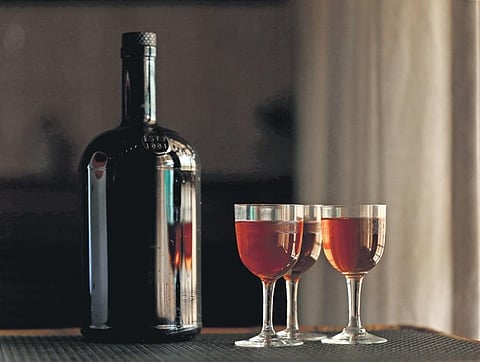

KOCHI: From the ancient vineyards of Mesopotamia to the bustling wineries of the 21st century, the journey of wine is indeed a captivating one.
Around 6000 BCE, the Sumerians began cultivating vineyards, stumbling upon the alchemical process of turning grape juice into wine. The resulting beverage, though starkly different from modern wines, marked the inception of a tradition that would persist through the ages.
As trade routes expanded, so did the knowledge of winemaking. The Egyptians, recognising the potential of fermented grapes, elevated wine to a symbol of luxury and religious significance. Meanwhile, the Greeks, true aficionados, took winemaking to new heights. Dionysus, the god of wine, became a central figure in Greek mythology, emphasising the divine connection between humans and their beloved beverage.
With the expansion of the Roman Empire, wine became a ubiquitous part of daily life. Romans improved upon Greek techniques, introducing innovations such as wooden barrels for ageing and refining grape varieties. Vineyards sprawled across Europe as Roman legions carried the art of winemaking to the farthest corners of their realm.
The fall of the Roman Empire brought a decline in winemaking, but it never disappeared entirely. Monasteries played a crucial role in preserving viticulture knowledge during the Middle Ages. Monks meticulously tended to vineyards, experimenting with blends and perfecting winemaking techniques. Subsequently, wine regained its status as a holy elixir, used in religious ceremonies and shared among the pious.
The Renaissance marked a cultural rebirth in Europe, and wine experienced a renaissance of its own. The French, in particular, elevated winemaking to an art form. The concept of terroir gained prominence, emphasising the unique combination of soil, climate, and grape variety that gives the wine its distinct flavour. Bordeaux and Burgundy emerged as iconic regions, showcasing the intricate nuances of wine production.
As European explorers set sail to discover new lands, they carried vines with them, introducing grape cultivation to the Americas, Africa, and Australia. The exchange of vine varieties between the Old and New Worlds enriched the global tapestry of wine. The Napa Valley in California and the wine regions of South America thus emerged as formidable players on the international stage.
The 19th century saw significant advancements in winemaking technology. The invention of the glass bottle and the introduction of corks revolutionised storage, allowing wines to age gracefully. Railroads and, later, refrigeration facilitated the transportation of wine across vast distances, connecting producers with consumers on a global scale.
Vine’s tryst in India
India’s wine history is rich but less known. Ancient texts mention ‘Sura,’ a form of wine, but it wasn’t as common as other traditional drinks like soma or arrack.
Wine’s presence in India dates back to the Indus Valley Civilization and grew through interactions with Persian and European cultures. It was reported that Emperor Akbar had a dedicated wine-taster, ensuring the quality and safety of his wine, a practice common among royalty to avoid poisoning.
Colonial rule in the 19th century marked the early days of Indian viticulture. Nashik, often referred to as the ‘Napa Valley of India’, has emerged as a wine hub. Surprisingly, India’s tropical climate, traditionally considered unsuitable for grape cultivation, has been turned into an advantage, allowing for two harvests a year in some regions — a rarity in the global wine industry.
Today, Indian wineries are experimenting with various grape varieties and winemaking techniques, creating wines that are starting to find a place in global wine competitions and on international wine lists. Globally, wine has always been important in ceremonies and social events, a trend that is now seen in India too. Wine festivals, tastings, and vineyard tours are getting popular, showing more interest in wine. There are also more wine education and sommelier courses in India.
Kerala’s secret
The process of making wine at home is a cherished ritual passed down through generations in Kerala. These ‘homemade’ wines, the recipes of which are family secrets, are often made from a variety of local fruits, including grapes, bananas, and even tropical fruits like pineapple and passion fruit. They are an
integral part of Christian festivities.
This homemade wine culture in Kerala showcases the versatility of wine as a beverage. It’s not just the commercially produced wines that hold a place in society, but also these deeply personal, handcrafted concoctions that carry the flavors and sentiments of their makers.
Food and wine pairing
Sparkling wine and appetisers: Light salty dishes balance the acidity of sparkling wines. Potato chips, fried mushrooms, sausages, and roasted tomato Bruschetta.
Red wine and red meat: If the meat has leaner cuts, pour some light or medium bodies wines. Whereas, fatty meats work well with bold red wines. Lamb, beef, veal, pork, and fillet are some chefs kiss combo with red wine.
Sweet wine and desserts: The sweetness of the wine can be balanced well with desserts like Note, here the wine should be sweeter than the dessert. Chocolate and caramel desserts, cheesecake, tiramisu, and apple pie.
White wine and sea food: Snapper, clams, and oysters are some refreshing contrasts.
Homemade wine recipe
Ingredients
3kg red grapes (preferred)
1kg sugar
3litres water
3tsp yeast (active dry yeast works well)
A handful or more of wheat kernels/godambu (optional)
A few cinnamon and cloves (Optional)
Tips for Color
METHOD
Note
Wine-making in Kerala extends beyond grapes. Explore possibilities with fruits like banana, nutmeg, orange, and pineapples. Also, prunes, peaches, and apples.